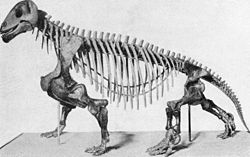Moschoides
|
Moschops Temporal range: Capitanian, 265–260 Ma |
|
|---|---|
 |
|
| Mounted skeleton | |
| Scientific classification | |
| Kingdom: | Animalia |
| Phylum: | Chordata |
| Order: | Therapsida |
| Suborder: | †Dinocephalia |
| Family: | †Tapinocephalidae |
| Genus: |
†Moschops Broom, 1911 |
| Type species | |
|
†Moschops capensis Broom, 1911 |
|
| Species | |
|
|
| Synonyms | |
|
|
Moschops (Greek for "calf face") is an extinct genus of therapsids that lived in the Guadalupian epoch, around 265–260 million years ago. Therapsids are synapsids, which were at one time the dominant land animals. Its remains were found in the Karoo region of South Africa.
Moschops was a roughly 2.7 metres (8.9 ft), massively built dinocephalian. It had a short, thick and massive head, which was broad across the orbits. Like other members of Tapinocephalidae, the skull had a tiny opening for the pineal organ. The occiput was broad and deep, but the skull was more narrow in the dorsal border. Furthermore, the pterygoid arches and the angular region of the jaw were quite heavy, allowing the insertion of strong jaw muscles. Due to that and because it possessed long-crowned, stout teeth, it is believed that Moschops was a herbivore feeding on nutrient-poor and tough vegetation, like cycad stems. Due to the presumably nutrient-poor food, it very likely had to feed for a very long time. Its anatomy allowed Moschops to open its elbow joint more widely, enabling it to move in a more mammal-like way than the other crawlers in its time. That might have helped it to carry its massive body more easily while feeding. Very likely, most dinocephalians were rather slow-moving animals, but capable of raising themselves, for short bursts. It is also possible that Moschops and other dinocephalians were semiaquatic, given the heavy build and the limbs with their spreading hands and feet. The heavy head could have been useful for diving after food.
Moschops had a thick skull, prompting speculation that individuals competed with one another by head-butting. Some doubt whether the Moschops were born with thick skulls. If they were, then Moschops' short, heavy tail may have counterbalanced the weight of its head. Its main enemies were very likely titanosuchids and the larger therocephalians.
...
Wikipedia
